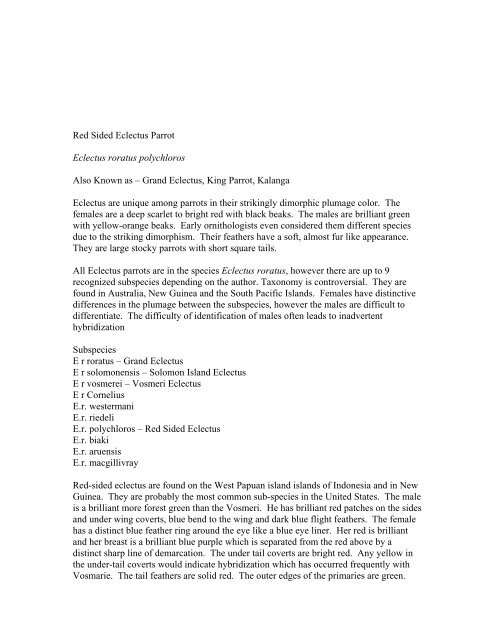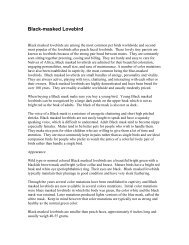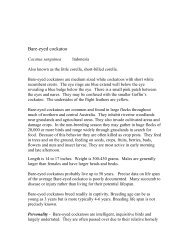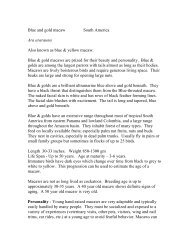Red Sided Eclectus Parrot Eclectus roratus ... - Susan Clubb
Red Sided Eclectus Parrot Eclectus roratus ... - Susan Clubb
Red Sided Eclectus Parrot Eclectus roratus ... - Susan Clubb
Create successful ePaper yourself
Turn your PDF publications into a flip-book with our unique Google optimized e-Paper software.
<strong>Red</strong> <strong>Sided</strong> <strong>Eclectus</strong> <strong>Parrot</strong><br />
<strong>Eclectus</strong> <strong>roratus</strong> polychloros<br />
Also Known as – Grand <strong>Eclectus</strong>, King <strong>Parrot</strong>, Kalanga<br />
<strong>Eclectus</strong> are unique among parrots in their strikingly dimorphic plumage color. The<br />
females are a deep scarlet to bright red with black beaks. The males are brilliant green<br />
with yellow-orange beaks. Early ornithologists even considered them different species<br />
due to the striking dimorphism. Their feathers have a soft, almost fur like appearance.<br />
They are large stocky parrots with short square tails.<br />
All <strong>Eclectus</strong> parrots are in the species <strong>Eclectus</strong> <strong>roratus</strong>, however there are up to 9<br />
recognized subspecies depending on the author. Taxonomy is controversial. They are<br />
found in Australia, New Guinea and the South Pacific Islands. Females have distinctive<br />
differences in the plumage between the subspecies, however the males are difficult to<br />
differentiate. The difficulty of identification of males often leads to inadvertent<br />
hybridization<br />
Subspecies<br />
E r <strong>roratus</strong> – Grand <strong>Eclectus</strong><br />
E r solomonensis – Solomon Island <strong>Eclectus</strong><br />
E r vosmerei – Vosmeri <strong>Eclectus</strong><br />
E r Cornelius<br />
E.r. westermani<br />
E.r. riedeli<br />
E.r. polychloros – <strong>Red</strong> <strong>Sided</strong> <strong>Eclectus</strong><br />
E.r. biaki<br />
E.r. aruensis<br />
E.r. macgillivray<br />
<strong>Red</strong>-sided eclectus are found on the West Papuan island islands of Indonesia and in New<br />
Guinea. They are probably the most common sub-species in the United States. The male<br />
is a brilliant more forest green than the Vosmeri. He has brilliant red patches on the sides<br />
and under wing coverts, blue bend to the wing and dark blue flight feathers. The female<br />
has a distinct blue feather ring around the eye like a blue eye liner. Her red is brilliant<br />
and her breast is a brilliant blue purple which is separated from the red above by a<br />
distinct sharp line of demarcation. The under tail coverts are bright red. Any yellow in<br />
the under-tail coverts would indicate hybridization which has occurred frequently with<br />
Vosmarie. The tail feathers are solid red. The outer edges of the primaries are green.
Length - 12-14 inches. Body weight - 380-450 grams<br />
Life Span probably up to 30+ years<br />
Age at maturity 2-4 years.<br />
Juveniles had black eyes and variable colored beaks, often brownish or streaked with<br />
black and yellow. Adult eye color is yellow in females and more orange in males.<br />
Personality - <strong>Eclectus</strong> tend to be aloof and independent, much as a cat. They rarely talk<br />
well but if given adequate attention can make good companions, especially males.<br />
Females tend to be more aggressive however some owners have wonderful relationships<br />
with their female <strong>Eclectus</strong>. <strong>Eclectus</strong> are not as noisy as many other large parrot species<br />
although they can make a very loud, screeching call when alarmed. They can be a very<br />
nice addition to a garden aviary. <strong>Eclectus</strong> have a characteristic, slightly musky smell.<br />
Activities - <strong>Eclectus</strong> will often appear stoic, especially if nervous, but are interested in<br />
activities around them and love to chew. They should always be provided with toys,<br />
especially wooden blocks or other toys that can be chewed, and branches from non-toxic<br />
trees. In order to ensure safety companion eclectus should not be allowed unsupervised<br />
freedom in the home as they often encounter toxins or dangerous items. Young eclectus<br />
should be socialized to many people and exposed to a variety of situations such as new<br />
cages, toys, visits to the veterinarian, handling by friends, wing and nail clips, etc to<br />
avoid fear of novel situations.<br />
Dietary needs - <strong>Eclectus</strong> do well when provided with plenty of fruits and vegetables.<br />
<strong>Eclectus</strong> should be fed approximately ¼ to 1/3 cup of a formulated diet as a basis for<br />
good nutrition. The diet should be supplemented with the at least the same quantity of<br />
fresh fruits and vegetables daily to add variety and psychological enrichment. Treats<br />
maybe given in small amounts especially as rewards for good behavior. Fresh clean<br />
water must be provided every day. Vitamin supplements are not needed for birds that are<br />
eating a formulated diet. Some breeders feel the colors and flavors in many formulated<br />
diets may cause “toe tapping”. Exact original diet would be a good choice as it does not<br />
artificial colors.<br />
If eclectus are fed a seed diet it must be supplemented with vitamins. Fresh fruits and<br />
yellow vegetables are a good source of vitamin A. Vitaminized seed cannot be relied<br />
upon to supply adequate vitamins as the vitamins are applied to the shell of the seeds that<br />
is discarded by the parrot.<br />
Grooming - Routine bathing or showering is vital to maintaining good plumage and skin<br />
condition. The fine feathering of eclectus is especially beautiful when they receive<br />
routine baths. Ideally birds should be taken outdoors on a warm day and lightly sprinkled<br />
and allowed to dry in the sun. Indoor birds can be misted or bathed in the shower and<br />
allowed to dry in a warm room or dried with a blow drier.
Care should be taken not to clip the wing feathers excessively. Clip only enough so the<br />
bird will glide to the floor. Usually clipping the first 8-10 feathers from the tip of the<br />
wing.<br />
Identification - All companion and breeding birds should be individually identified to<br />
assist in recovery if lost and assist in maintenance of medical and genealogical records.<br />
Many breeders apply closed legs bands when chicks are young. While they present a<br />
slight risk of entrapment closed bands are preferable to no identification, especially for<br />
breeding birds. Microchips, which can be implanted into the muscle or under the skin,<br />
are a reliable means of identification but require electronic readers to verify<br />
identification. Tattoos may be used but often fade or become illegible with time.<br />
Footprints may have some application in identification.<br />
Sexing - Female eclectus parrots are various combinations of brillant reds, blues and<br />
purples, depending on the subspecies. The beak of the female is black. Males are<br />
brilliant green with an orange beak.<br />
Specific housing or care needed - <strong>Eclectus</strong> should be provided with as large a cage as<br />
possible. Appropriate toys should be provided.<br />
Breeding season and clutch size - <strong>Eclectus</strong> parrots are prolific breeders and many pairs<br />
will breed year round. The prominent breeding season is the spring. Females tend to be<br />
aggressive toward males and infertility is a big problem especially in older ectectus. This<br />
may be associated with female domination of males. There are reports of eclectus<br />
breeding successfully until age 28+.<br />
Nest Box - <strong>Eclectus</strong> breed well in a vertical nest box approximatley 18” x 18” x 24”.<br />
Females may stay in the box most of the time. Pine shavings make excellent nest<br />
material.<br />
The breeding cage should be as large as practical but at least 3’ x 3’ x 6’.<br />
<strong>Eclectus</strong> are easy to hand rear and will do well on Exact Macaw hand rearing formula.<br />
The sexes can be distinguished at a very early age and the down tends to be black in<br />
female chicks and grey in males. At about 2 ½ to 3 weeks the head will take on a green<br />
or red cast as feathers emerge and tails feathers will begin to emerge verifying sex.<br />
<strong>Eclectus</strong> chicks must be handled very gently to avoid fearful or aggressive behavior.<br />
Common diseases and disorders<br />
• Feather picking<br />
• Psittacosis -Chlamydophilia (Chlamydia) infection<br />
• Vitamin A deficiency<br />
• Psittacine Beak and Feather Disease<br />
• Polyoma virus infection<br />
• Proventricular dilation disease<br />
• Bacterial infections
• Candida (yeast) infections<br />
• Ingestion of toxins such as heavy metals<br />
• Infertility and female aggression<br />
• Clostridium infection<br />
Many common health problems of <strong>Eclectus</strong> can be prevented by good diet, nutrition and<br />
routine health care. Routine veterinary examination (annually) can help you to keep<br />
your pet in excellent health and enhance your relationship with your bird.<br />
Many common health problems of <strong>Eclectus</strong> can be prevented by good diet, nutrition and<br />
routine health care. Routine veterinary examination (annually) can help you to keep<br />
your pet in excellent health and enhance your relationship with your bird.<br />
Conservation Status - Stable, locally common <strong>Eclectus</strong> are listed on Appendix II of<br />
CITES (Convention on International Trade in Endangered Species. They are frequently<br />
bred in the United States and are readily available however pure sub species can be<br />
difficult to obtain.






